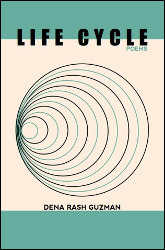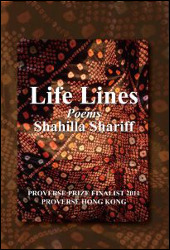|
by Cecilia Chan
 
Dena Rash Guzman, Life Cycle, Dog On A Chain Press, 2013. 69 pgs.
Shahilla Shariff, Life Lines, Proverse Hong Kong, 2012. 80 pgs. What is the poem A distillation of anything What is anything Anything is a story What are the stories The stories are life cycles —Dena Rash Guzman, a self-interview poem, The Nervous Breakdown Thus begins the dramatic opening of Dena Rash Guzman's debut poetry collection, Life Cycle: A good story should take men, a lot of them at once. It conjures a cast of drowning sailors, passengers in distress, the captain well maintaining his composure, waiters, and perhaps a whale not far away. In this collection, each poem bears the same title, "Life Cycle," thus offering no hints to the reader on what to expect. It immerses the reader into each new episode as the poet-persona takes on a new role in each of them—all of which have no less impact than the shipwreck scene that commences the book. One cycle ends, succinct and abrupt, and another starts anew. After the shipwreck scene, the next life cycle stands the test of time: I'm wood-clad, weathered,
gray by snow and sun.
The lights inside my stories flicker.
The moon wanes and fills. […]
I decay over decades, but hold. Another cycle takes the form of two coyotes attracted to each other, possibly heralding a new life: I was only a cold coyote
breathing desert dust,
sharp and gray on a red hill.
You were only another coyote,
head down and tail up,
sniffing a mouthful of kill. Then there is the story of the poet-persona's great-grandmother, whose legacy of biscuit making will thrive only as long as the life of an inherited wooden bowl: Now I have the wooden bowl.
It rests on my highest shelf.
When I die, it will be thrown away
because it is cracked nearly in half. And a cycle that renews every day: Nights we sing our bones to sleep,
then our nerves back from it.
Each day we get a dawning,
a hot cake from the oven. There are also tensions amid the calm and unsuspecting moments: Faith is the space
between the flesh of a peach
and the knife.
Faithlessness: a slice
of skin, not peach. Each poem captures a specific span of time, in which drama unfolds, and the book makes a disparate concoction of bold, cryptic, unconventional and wildly imaginative stories. Thus the experience of reading this collection can be likened to solving riddles based on the parameters of the setting, the imagery and the voice of each poem. In Life Cycle, each story has a life of its own, the creations of a poet who herself takes on many incarnations. Unlike the many personas used by Dena Rash Guzman, Shahilla Shariff speaks in a personal voice and reflects on her past experiences in her collection Life Lines. "Life Lines began with an encounter and a gift," Shariff writes in the introduction of her book. According to her, an old Bedouin woman from the oasis of El Ain gave her the gift of a gold ring etched with the rough lines of a desert palm. This marks the beginning of the poet's search through the memories and places she has travelled, through external and internal landscapes. Each poem refers to a collection of objects and imagery laden with symbolic meaning. Taken together, the collection represents a quest to construct a life line which dates back to folklore and the poet's ancient forbearers and links her to the unknown future. Time stretches in each poem; thoughts of a departed person, an encounter abroad and a treasured object bring back a rush of memories. "Many of these poems began as a meditation on grief. Memories shaped poems; poems shaped memories," Shariff writes at one point. In "The Taste of Rain," the sound of amber prayer beads clicking against each other, the taste of rain and the scent of jasmine on a nightstand remind the poet of her great-grandmother and her mother and herself. The poet collects images that relate her to her ancestors: I freeze the frames,
bury my time capsule along with the old me.
Start the new life of a survivor,
all in an impossibly cold country. In "Later," a sari holds the key to the past, along with misinterpretation and regret: He wondered why you never
draped it over you, why you left it
on a shelf to be anointed by dust.
You could have given it away.
Later, later was what you always said.
You only remembered
when he was no longer there
to make you blush
the contours of regret. And in "Malaika," a blessing takes the form of the gift of a betel nut box: You said it would sweeten my life
when I inherited the pungent bitterness
of cloves enfolding your Zanzibar childhood,
the papaya orange Swahili sun staining your heart. These images and objects symbolise the love, hope and expectation that words fall short of expressing. They transport the poet-persona out of space and time. As each poem meanders through memories and symbols, its title highlights the central theme and helps the poet negotiate where she stands. In other poems, the poet confronts herself. "Singing My Redemption" reveals her strong will and lifelong struggle: I entered kicking, screaming,
never stopping.
Born fighting,
I won't fight dying.
My voice by then will sing
its own redemption. "Maya" contemplates life and death: Is peace a place or a thing?
Is there any point in praying for an easy life,
an easy death being the essential thing? In the end, the title poem "Life Lines" brings together all the memories, encounters and contemplations. It echoes the poet's meeting with the Bedouin lady and the gold ring, which inspired the collection in the first place: An oasis however crudely scratched
on the ring you rushed
from your finger onto mine.
I am not where I started.
I am not yet strangled by winds,
but the lines, they remain fixed. And so concludes the life line that runs through this poetry collection. "Only on finishing Life Lines did I pull the ring off and put it away in a box," Shariff writes in the introduction. In the same fashion, the collection is complete. |